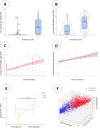The neurobiology of aesthetic chills: How bodily sensations shape emotional experiences
- PMID: 38383913
- PMCID: PMC11233292
- DOI: 10.3758/s13415-024-01168-x
The neurobiology of aesthetic chills: How bodily sensations shape emotional experiences
Abstract
The phenomenon of aesthetic chills-shivers and goosebumps associated with either rewarding or threatening stimuli-offers a unique window into the brain basis of conscious reward because of their universal nature and simultaneous subjective and physical counterparts. Elucidating the neural mechanisms underlying aesthetic chills can reveal fundamental insights about emotion, consciousness, and the embodied mind. What is the precise timing and mechanism of bodily feedback in emotional experience? How are conscious feelings and motivations generated from interoceptive predictions? What is the role of uncertainty and precision signaling in shaping emotions? How does the brain distinguish and balance processing of rewards versus threats? We review neuroimaging evidence and highlight key questions for understanding how bodily sensations shape conscious feelings. This research stands to advance models of brain-body interactions shaping affect and may lead to novel nonpharmacological interventions for disorders of motivation and pleasure.
Keywords: Arousal; Chills; Dopamine; Emotional; Film; Learning; Music; Precision; Reward; Valence.
© 2024. The Author(s).
Conflict of interest statement
In the past years, FS founded and received compensation from BeSound SAS and Nested Minds LTD. Over the past 3 years, Dr. Pizzagalli has received consulting fees from Albright Stonebridge Group, Boehringer Ingelheim, Compass Pathways, Engrail Therapeutics, Neumora Therapeutics (formerly BlackThorn Therapeutics), Neurocrine Biosciences, Neuroscience Software, Otsuka, Sunovion, and Takeda; he has received honoraria from the Psychonomic Society and American Psychological Association (for editorial work) and from Alkermes; he has received research funding from the Brain and Behavior Research Foundation, the Dana Foundation, Millennium Pharmaceuticals, Wellcome Leap MCPsych, and NIMH; he has received stock options from Compass Pathways, Engrail Therapeutics, Neumora Therapeutics, and Neuroscience Software; he has a financial interest in Neumora Therapeutics, which has licensed the copyright to the probabilistic reward task through Harvard University. Dr. Pizzagalli’s interests were reviewed and are managed by McLean Hospital and Partners HealthCare in accordance with their conflict of interest policies. No funding from these entities was used to support the current work, and all views expressed are solely those of the authors. All other authors declare they have no competing interests. All other authors have no conflicts of interest or relevant disclosures.
Figures





References
-
- Adcock, R. A., Thangavel, A., Whitfield-Gabrieli, S., Knutson, B., & Gabrieli, J. D. (2006). Reward-motivated learning: mesolimbic activation precedes memory formation. Neuron, 50(3), 507–517. 10.1016/j.neuron.2006.03.036 - PubMed

